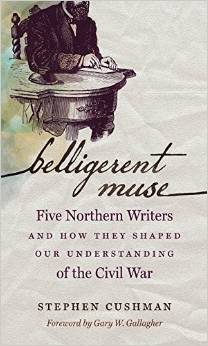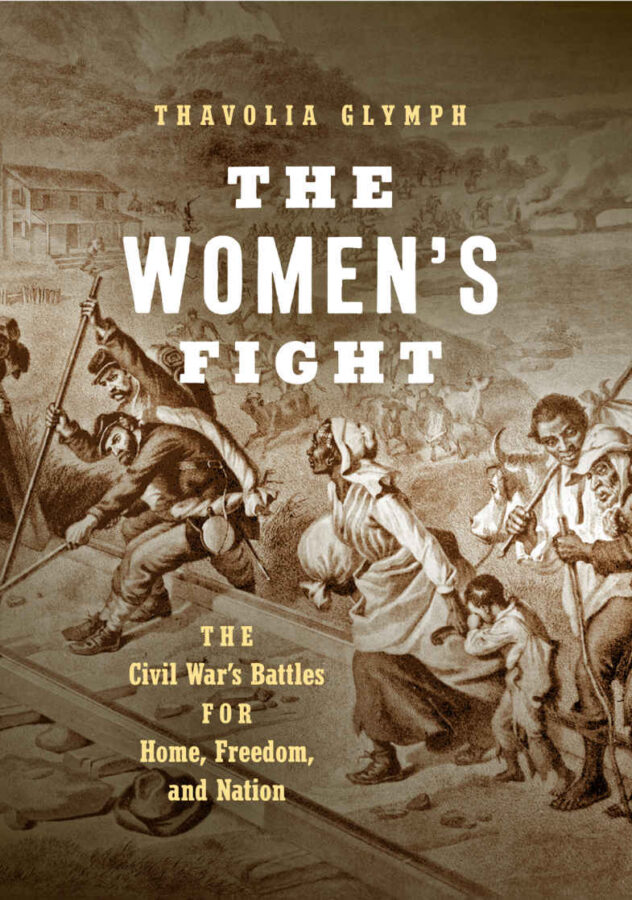Belligerent Muse: Five Northern Writers and How They Shaped Our Understanding of the Civil War by Stephen Cushman. University of North Carolina Press, 2014. Cloth, IBSN: 978-1469618777. $28.00.
 As Stephen Cushman notes, wars not only destroy, they also create. Perhaps more than any other, the American Civil War has produced a prodigious river of print. For generations, scholars have faced the herculean task of trying to make sense of all these words. In Belligerent Muse: Five Northern Writers and How They Shaped Our Understanding of the Civil War, Cushman offers one way of navigating this prose flood: one that selects certain texts from representative authors (so far so good) and then demands a new way of reading. Such an approach allows Cushman to “blend” an interest in “the history of the American Civil War with an interest in the verbal patterns, shapes, conventions, and strategies of written narratives about it” (3). Cushman’s interest in the relationship between waging and writing war informs his selection of authors: four of his five served on the battlefield, one in the Executive Mansion. In order to pull this project off, Cushman must take seriously these men, most of whom are known for something other than their literary prowess, as writers sensitive to the demands of their craft. At times, the result is a stunningly illuminating exploration of the ways in which historical documents reveal more than the history of past events. As Cushman convincingly demonstrates, they also reveal something about “linguistic, rhetorical, and literary history” (5).
As Stephen Cushman notes, wars not only destroy, they also create. Perhaps more than any other, the American Civil War has produced a prodigious river of print. For generations, scholars have faced the herculean task of trying to make sense of all these words. In Belligerent Muse: Five Northern Writers and How They Shaped Our Understanding of the Civil War, Cushman offers one way of navigating this prose flood: one that selects certain texts from representative authors (so far so good) and then demands a new way of reading. Such an approach allows Cushman to “blend” an interest in “the history of the American Civil War with an interest in the verbal patterns, shapes, conventions, and strategies of written narratives about it” (3). Cushman’s interest in the relationship between waging and writing war informs his selection of authors: four of his five served on the battlefield, one in the Executive Mansion. In order to pull this project off, Cushman must take seriously these men, most of whom are known for something other than their literary prowess, as writers sensitive to the demands of their craft. At times, the result is a stunningly illuminating exploration of the ways in which historical documents reveal more than the history of past events. As Cushman convincingly demonstrates, they also reveal something about “linguistic, rhetorical, and literary history” (5).
Cushman chooses five writers familiar to any student of the Civil War—Abraham Lincoln, Walt Whitman, William Tecumseh Sherman, Ambrose Bierce, and Joshua Lawrence Chamberlain. These men are no strangers to word parsers; think of Ronald C. White, Jr.’s, Lincoln’s Greatest Speech: The Second Inaugural, or of David S. Reynold’s Walt Whitman’s America: A Cultural Biography. Yet Cushman’s finely honed, “historically informed aesthetic sensibility” allows him to read his chosen authors in entirely new ways. Cushman moves well beyond historicizing the texts. He is not interested in merely connecting the “verbal form” with content. Indeed, he finds such an approach impoverished. Of Lincoln’s Gettysburg Address, for example, he asserts: “There is something naïve about the insistence that Lincoln’s careful auditory connections between and among words, phrases, clauses, and sentences […] somehow reflect or represent or imitate or enact the binding together of the wounded and disintegrating” (36). For Cushman, the more interesting consideration is how Lincoln combined “particular sounds” to produce “impressions of aesthetic or emotional intensity” (37-38).
Such readings change how we think about figures on whom we’ve already done a great deal of thinking. Few have considered Sherman as a writer, for example, with “highly developed aesthetic sense of artistry” (72). Yet the Sherman who emerges in Belligerent Muse was a master of his craft, and Memoirs of General William T. Sherman exhibit his intimate familiarity with certain literary conventions popular in the mid-nineteenth century, including the travel narrative, the apologia, and the epistle. The work also displays Sherman’s visual sensibility, “a kind of pictorial, painterly attention to scene,” as well as an auditory sensibility, “one that pointed beyond music to the carefully orchestrated sounds of Sherman’s own sentences” (79-80). Finally, Memoirs reveals the same kind of control that Sherman exhibited as a soldier. Sherman had learned early on that others’ perceptions of him mattered. What he chose to omit, to include, or to document, when he chose to quote directly or resort to indirect discourse, ensured that readers saw the man he meant them to see. To read Memoirs as merely a document of the war, Cushman thus warns, is to fail to recognize it as an “artistic achievement” (72).
Cushman is less successful in his final, brief chapter on Chamberlain, which centers on how Civil War historians have addressed Chamberlain’s role in the surrender ceremony at Appomattox. The question boils down to whether Chamberlain ordered his men to salute surrendering Confederates, thus altering the tone of the ceremony. The question matters, as Cushman tells us, because so much of what we think we know about Chamberlain’s role comes from Chamberlain himself, and the Union general produced no fewer than six accounts, over the span of fifty years, for increasingly public audiences; the first was a letter to his sister written the day after the surrender, the last an account in his memoir, published posthumously in 1915. The question matters, too, because historians have taken it seriously. Some see Chamberlain’s earliest iterations as definitive and thus truthful; subsequent revisions and embellishments merely expose Chamberlain as a self-aggrandizing blowhard. Others use the accounts indiscriminately, drawing on the various versions untroubled by the different stories the accounts ostensibly tell. Civil War historians, it seems, either trust Chamberlain as a narrator or they do not. Fair enough. Yet Cushman cautions those who would so easily dismiss Chamberlain for his postwar embellishments. He reminds us, and rightly so, that an earlier memory of an event is not necessarily more reliable or “truthful” than a later memory. Neither do inconsistencies perforce negate the reliability of other claims made in the different accounts. Rather, Cushman suggests, “[t]his kind of imperfection or flaw in recollection actually may be a sign of authenticity rather than falsehood, whereas exact, undeviating repetition of precisely the same details over fifty years could characterize the rigidly rehearsed consistency of a liar” (158).
While Cushman offers us a valuable lesson on how to think about the role memory plays in shaping narrative accounts of past events, his last chapter does little to move us away from the “did he” or “didn’t he” debate. Indeed, for one so attuned to the ways in which words occlude as well as illuminate, Cushman might be better served by asking entirely different questions of Chamberlain’s seemingly competing narratives. Rather than ask what these six accounts have to tell us about a precise and fixed moment in time, we might instead consider what these narratives have to tell us about Chamberlain’s attention to audience (private, local, regional, and national), about the changing needs and demands of a postwar reading audience increasingly separated from the moment in question by time, and about the ways in which a modernizing postwar publishing industry strove to meet those demands.
The Chamberlain chapter falls short only because the other chapters rise to such daring heights. Belligerent Muse is an elegant and sophisticated meditation on the ways in which the construction of language tells much more than just the events recounted. In the hands of the accomplished writers considered, language shapes the past’s meanings and its perceptions.
Sarah E. Gardner, Professor of History and Director of Southern Studies at Mercer University, is the author of Blood and Irony: Southern White Women’s Narratives of the Civil War, 1861-1937.
